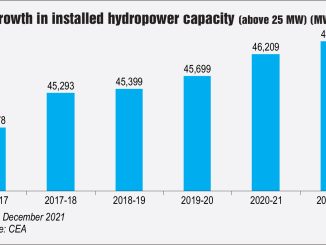Pumped storage plants (PSPs) are being recognised as one of the largest forms of storage available at a competitive cost. It is a mature technology that offers the benefits of simple design, ease of scalability and operation, and quick ramping. Further, in view of the large renewable energy capacity addition planned for the next few years, PSPs are expected to play a vital role in providing clean and balancing power. This will help address the variability and uncertainty issues associated with renewable energy sources. Pumped hydro energy storage (PHES) not only generates and stores electricity but also has other use cases such as round-the-clock support, load following, energy arbitrage, peak shaving, renewable energy smoothening and ancillary services.
Status of PSP development
As per the Central Electricity Authority (CEA), India has eight pumped storage projects, with a total capacity of 4,745.6 MW as of November 2021, installed in various locations across the country. However, only six plants with an installed capacity of 3,305 MW are working in the pumped mode. The remaining 1,480 MW of capacity across two sites is not currently operational because of the delay in the construction of tail pool dams and vibrational issues. Further, there are two under-construction PSP projects with a total capacity of 1,500 MW. The 1,000 MW (4×250 MW) Tehri Stage II project in Uttarakhand being implemented by THDC Limited is likely to be commissioned by 2023-24. It will be the first PSP in the central sector. The 500 MW (4×250 MW) Kundah PSP Stages I, II, III and IV, being implemented by the Tamil Nadu Generation and Distribution Corporation in Tamil Nadu, is likely to be commissioned by 2023-24. Meanwhile, construction of the Koyna Left Bank (80 MW) power project in Maharashtra, being implemented by the Water Resources Department of the state, is held up.
The CEA has estimated the overall potential of PSPs in the country at 96,524 MW across 63 projects. Currently, survey and investigation are in progress for 17 projects totalling 16,770 MW. The detailed project report (DPR) for the Turga project (4×250 MW) in West Bengal has been approved, while the 1,200 MW Pinnapuram project in Andhra Pradesh is under examination. In addition, DPR/ preliminary investigation report/pre-feasibility report (PFR) has been prepared for 7,755 MW. However, the PFR for 1,100 MW is under preparation.

Issues and challenges
Despite various advantages of a PSP, the growth of PSPs in the country is slow. The CEA has estimated a PSP potential of 96 GW, of which only 3.3 GW is currently operational in India. This slow pace can be attributed to the high cost associated with the commissioning of PSP, the long gestation period (due to delays in obtaining environmental clearances) and poor recovery from the existing pricing mechanism of PHES. There are also issues regarding finding a suitable site, finalising the project layout, operating restrictions during the monsoon, machine selection and equipment delivery schedules. PSP adoption is further hampered by monopoly in equipment supply and limited financing options. Another issue pertains to the existing tariff mechanism for PSPs, which ensures the recovery of the full cost of the PSP over the years. This hampers private investment in the sector. That said, there is an urgent need for a pricing mechanism that can ensure profit generation for developers over and above their fixed cost and variable cost components. Last but not the least, guidelines for the development of pumped storage also need to be framed.

The way forward
Going forward, as per the CEA’s optimal generation mix, it is expected that pumped hydro storage will almost triple by 2030. With hydropower stations’ fast-ramping capability and the ability to respond more quickly than thermal stations, storage and pondage hydropower stations are proposed to be gainfully utilised for regulation services to meet the system requirements. Flexibility of PSPs, that is, fast ramp rates, fast start-up and shutdown, and low cycling costs, make them ideal suppliers of regulation and contingency reserve ancillary services. With greater integration of renewable energy, the role of PSPs is expected to increase in the coming years as they can act as energy reservoirs to balance load.



